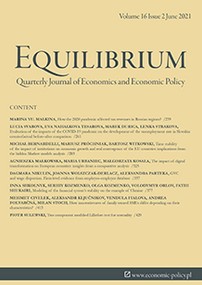GVC and wage dispersion. Firm-level evidence from employee-employer database
GVC and wage dispersion. Firm-level evidence from employee-employer database
Author(s): Dagmara Nikulin, Joanna Wolszczak-Derlacz, Aleksandra PartekaSubject(s): Labor relations, Human Resources in Economy, Socio-Economic Research
Published by: Instytut Badań Gospodarczych
Keywords: wage inequalities; Global Value Chains; ineqrbd; regression-based decomposition;
Summary/Abstract: Research background: Wage inequalities are still part of an interesting policy-oriented research area. Given the developments in international trade models (heterogeneity of firms) and increasing availability of micro-level data, more and more attention is paid to wage differences observed within and between firms. Purpose of the article: The aim of the paper is to address the research gap concerning limited cross-country evidence on a nexus of wage inequality–global value chains (GVCs), analysed from the perspective of wage inequality components within and between firms. Methods: This paper uses a large employee-employer database derived from the European Structure of Earnings Survey (SES), combined with sector-level indicators of GVC involvement based on the World Input-Output Database (WIOD). As a result, a rich database covering more than 7.5 million observations is created. The regression-based decomposition modelling technique developed by Fiorio and Jenkins (2010) is used to identify the contributions of different factors to wage inequalities, focusing on the components within and between firms. Findings & value-added: The analysis presented in this paper aimed to show the contribution of GVC involvement, among various other factors, to the observed inequality of wages. Due to the use of a rich database that merges employer and employee data, the effects materialised with respect to different types of wages could be analysed separately, in particular components between and within firms. The general conclusion from the regression-based decomposition in log wages is that GVCs contribute marginally to the observed wage inequality in the European sample analysed in this paper. Some differences confronting the components within and between firms (the latter dominates) are observed; there is also certain intra sample heterogeneity in the estimated results (e.g. due to sector type or country group), but the general result is robust.
Journal: Equilibrium. Quarterly Journal of Economics and Economic Policy
- Issue Year: 16/2021
- Issue No: 2
- Page Range: 357-375
- Page Count: 19
- Language: English

